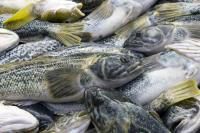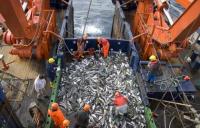
Marbled Antartic cod (Notothenia rossii) Five tons of marbled Antarctic cod (Notothenia rossii), now that was surely a big surprise to scientists and crew on board of Polarstern, alike considering that previous and subsequent hauls barely ever reaped such plentiful harvests.

Fish cath in Antartic waters with research vessel Polarstern Their shimmering silver and dark blue bodies, which can grow up to 70 cm, were piled on the aft deck of the research vessel maintained by the Alfred Wegener Institute for Polar and Marine Research.
In combination with previous stock assessments, fisheries biologists onboard interpreted the catch as a sampling of a discrete, small-scale aggregation of this fish species.
There are two hypotheses to explain the observed dense aggregation: 1. krill, the main prey of marbled Antarctic cod, aggregate to form a band of dense shoals in close vicinity to its preferred habitat; and 2. certain seafloor topographies, such as canyons or cliffs may be conducive to its aggregation. The tendency to shoal made them an easy target for commercial fisheries in the past. After depletion of marbled Antarctic cod stocks the "Convention on the Conservation of Antarctic Marine Living Resources" (CCAMLR) decided to ban fishing activities. Resuming commercial fisheries could easily lead to stocks being overfished. Germany, represented by the Federal Research Centre for Fisheries, is constantly providing results to the responsible CCAMLR working group to prevent overexploitation of Antarctica's fish stocks.
Source : Alfred Wegener Institute for Polar and Marine Research
 Print Article
Print Article Mail to a Friend
Mail to a Friend
